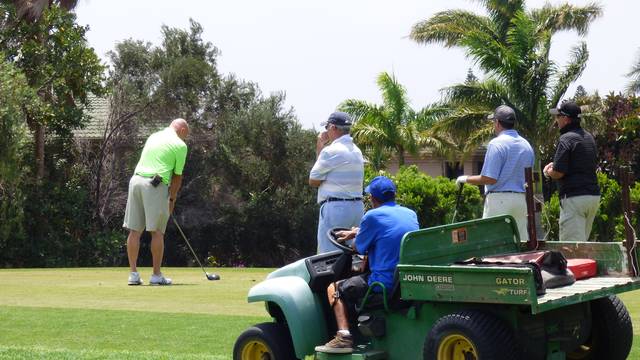Debate rages in Waikoloa Village over homeowner subsidization of golf course
WAIKOLOA — When Waikoloa Village was constructed by developer Boise Cascade in the 1970s, it was intended as a retirement community meant to revolve around a golf course. In recent months, however, some homeowners there have challenged the viability and necessity of that paradigm.
Amy Swan, president of the Waikoloa Village Homeowners Association (WVA) Board of Directors, explained why she believes the debate has gained so much traction after four decades of relative dormancy.
“I think this community is much more diverse than it used to be and they’re starting to get involved,” she said.
The course has come under fire from some members of the WVA who note it operates perennially at a financial loss, which has led to an increase in association fees from $620 annually in 2016 to $795 in 2017.
Initially, the proposed increase put yearly fees at nearly $1,000. That number was scaled back after a vocal portion of the community decried such a steep hike, threatening lawsuits, stating their intention not to pay their dues and spurring discussions about dissolving the WVA entirely.
Roger Hansen, a resident of the Village since 1981, said in an email that the transfer of the financial burden to maintain the course can be traced back to mistakes made by the WVA Board of Directors some 30 years ago.
“Until … 1987/88 the WVA course was a resort course, supported and subsidized initially by Boise Cascade and subsequently Transcontinental Development,” he wrote. “Any losses of the WVA were made up for by these billionaire entities. The WVA suddenly became a municipal course supported only by its members and whatever nonresident play they could attract.”
Some of the increase in dues are to subsidize the course’s financial losses, which Director of Golf Matt Leininger said range between roughly $250,000-$400,000 annually. However, much of the fee hike is intended to bulk up a reserve fund for course maintenance and improvements into the future.
To residents like Richard Apothaker, the 150-acre communal course — which is owned in part by every homeowner in the Village — isn’t worth the hassle. He cited numbers obtained from the WVA Board of Directors that indicate less than 10 percent of golf is being played by association members.
“I’m not a golfer and golf doesn’t mean anything to me emotionally,” he explained. “What it means to me is it’s an asset. It’s probably the largest single shared asset of the community. Anything that causes this asset to gain value is a good thing. Anything that causes it to lose value is a bad thing.”
Proponents of maintaining the status quo cite the benefits not only to golfing enthusiasts who automatically become members upon purchasing a home, but to all homeowners because of the increase in property values it provides throughout the area.
“Traditionally, people in Waikoloa Village have been willing to pay for amenities they don’t actually use because the amenities add value to our properties and make our community a better place to live,” said Village resident Richard Gillette. “More recently, some people have decided they no longer buy into that theory.”
Leininger said he’s heard from many homeowners, timeshare owners and vacationers that if the course ceased to exist, they’d have no reason to frequent the area and would go elsewhere. Rick and Sylvia Bouma, who often vacation in Hawaii and were enjoying the course Monday, numbered among those who held that opinion.
“If they get rid of this, I’m not coming to the Big Island anymore to tell you the truth,” Rick said.
Despite the passionate arguments on both sides, Swan said most of the fuss around the issue is likely for naught. That is because repurposing it would be an astronomical feat.
First, the board would need to approve a vote of all association members on the issue by a majority vote of at least 4-3. After that, upwards of $30,000 would need to be spent on legal fees and the distribution of a paper ballot just to conduct a vote.
Lastly, a majority of association members — more than 1,500 households — would have to vote in favor of repurposing the course. Swan said there’s never been a vote to her knowledge in which more than 1,100 households even participated.
And all of this would only allow for the founding documents, which were drafted by Boise Cascade and mandated the existence of a golf course, to be amended.
Swan also said that an idea to repurpose the course that would also create revenue and keep the space green has yet to be proposed.
Apothaker has suggested inviting TMT to set up its campus there, but there is no guarantee TMT will even build facilities on the island as the project atop Mauna Kea remains in question. Even if the telescope is built and TMT accepted an invitation to construct its headquarters in Waikoloa Village, Swan said the project would only take up three acres, leaving 147 left to be utilized.
The only other idea Swan has encountered is turning the area into a park. But Leininger explained the cost of electricity to pump water and irrigate the course from an aquifer that sits 1,100 feet underground costs in the neighborhood of $500,000 per year. That cost would remain if the course were transitioned to a park.
He added other expenses, such as security and maintenance for the park, have put cost estimates of such an endeavor at between $600,000-$800,000 per year. As a park would produce no profits, homeowners would have to absorb that cost instead of the rough average of $300,000 annually they pick up to subsidize the golf course.
Swan said a study the Board commissioned found transitioning from a golf course to a park would increase association dues by $330 per person and and could open the WVA up to lawsuits from homeowners.
Leininger, who has been party to most of the discussions surrounding the debate, put the likelihood of any changes in simple terms.
“I have a pretty good sense of what’s going to happen, which is most likely nothing,” he said.





